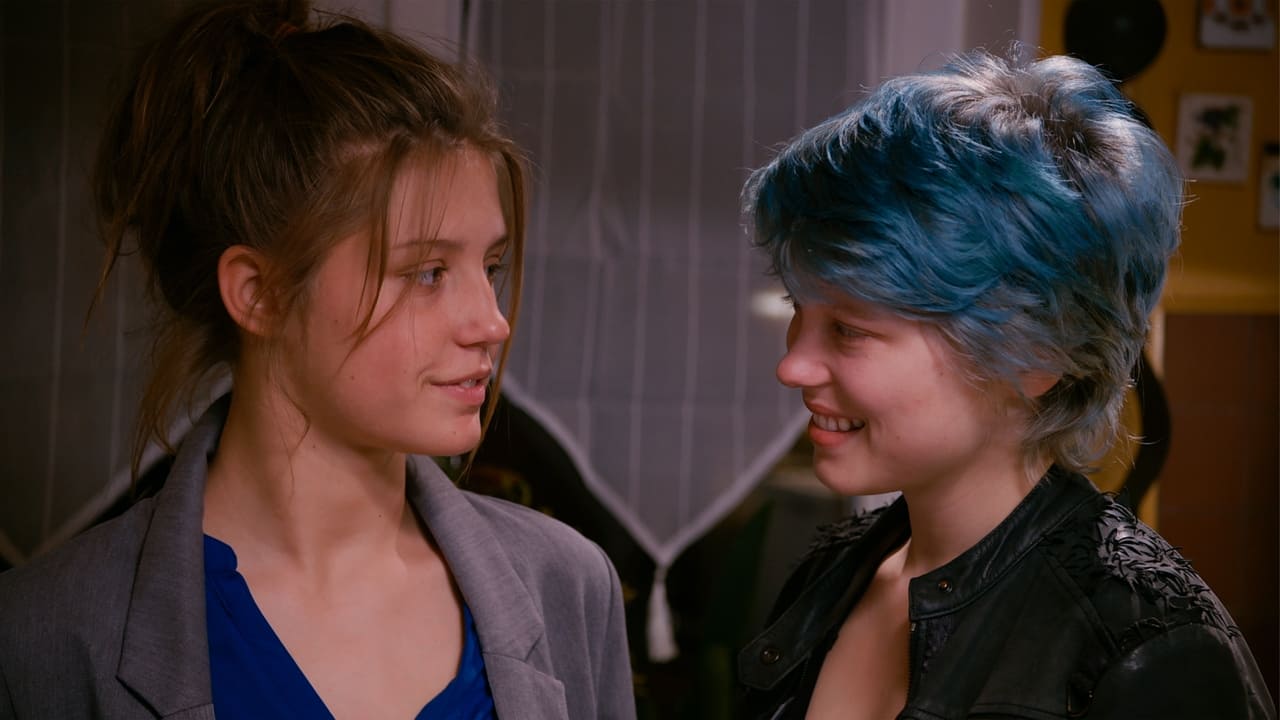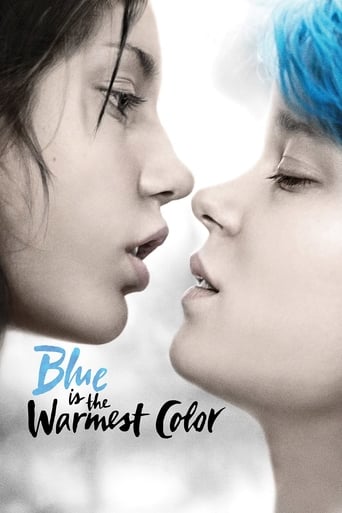

First of all, this is the film for open minded and honest viewers. It does not require "educated" or "well informed" viewers, but only honest to themselves. For this reason, there are a lot of middle class, small minded intellectual ( lesbian) critics who will attack this film for not being "truthful" to the"real" nature of woman to woman love, and being seen through a male gaze. However, this is actually a film about woman to woman love, and woman to woman attraction, sex, union, betrayal, break up, and closure. It is also a film about first real love, and first (and possibly only) real sexual connection with another person. The fact that the director is a man does not mean so much: two lead actresses performed that relationship on the screen with an attitude, apparently firmly believing in what they were doing, much more than big names in dozed and "psychologically framed", "decent" other lesbian themed movies. This is a story about emotions and psychological development of a young woman told in a way which is different than usual: she feels the things with her body, with her skin, with her lips, and thats how she learns stuff and makes mistakes. She is not well read and well educated and she does not have anyone to talk to, so she cannot rationalize what is happening to her. She takes the stuff as they are, and thats why everything looks somehow raw, illogical and stupidly done, because thats how the life is. The film does have certain slippages in the narrative. The Emma story part is a bit underdeveloped, and requires a bit of viewers' reading into the story. For instance, in the end, after the break up, it might seem that Emma is happy with the new partner; however, it is also suggested that actually its not about being happy: she just made her new life settled and bearable. She is able to function as a person and artist with a new partner, to have a family, while with Adele she was painfully aware that it cannot last, and that this intensity cannot be functional. Too much love and obsession can kill the love, so Emma lets it happen, rather than to sacrifice other stuff for love. She wants Adele to change, and become more socially accommodated for her, and when it does not happen, Emma lets their love fade, preoccupied with her career. One mistake, Adele's meaningless affair with a guy, was enough for Emma to take her revenge and end their love. This part is a bit unclear: was she really hurt that much, or was she already aware, even before that, how impossible their love was? It seems the latter is at stake. It also seems that she got over Adele, but that is just her high class training on how to handle something potentially painful. In the end, lets just say, dear lesbians, dont pretend that lesbian sex is not that lustful. It is, just it does not happen with that intensity with everyone. That line, between authentic sex and vanilla sex, is very well drawn in the last scene, when Emma admits that sex with her new(old) partner is "different" than with Adele. Love is a heavy thing, and when it really happens, it leaves a deep trace, not only in one's mind, but also on every part of one's body. Also, real love and attraction cannot survive in the life full of trivialities and other frustrations. Love without calculations never lasts. Unlike Adele, who has had it for the first time, Emma, who is older, knows it, and thats why she ends it without looking back, thats why she is a cruel one. This is the part which could have been more underlined in words and dialogues, but than the film would have been a bit intellectualized, and the director apparently wanted to avoid it. If you are open minded, don't miss this movie, because even your children will talk about it.
... View MoreThis movie received glowing reviews by the lgbt community, so I finally gave it a chance. It begins realistically, with a girl thinking she's straight, and having typical experiences. Her sexual awakening is one that can be appreciated. That being said, I grew bored with it. I am unfortunately disappointed with this movie.
... View Morethis movie is pretty meh... it has like two great scenes in it and that's literally just because those scenes are made to be (surprisingly great) porn. everything else about this movie is boring. the filmmakers forgot that the one thing no one wants to see in porn is ,,story'' and scenes of people just doing things other than what you expect from porn. not just that but they added 3 hours of boring scenes to those 2 normal scenes that actually serve the purpose. final rating: 3/10 just because of these 2 amazing scenes it's not a 1 or 2
... View MoreAbdellatif Kechiche's "Blue is the Warmest Color" is often a study of facial landscapes. Specifically, that of Adele Exarchopoulos, whose performance is one of great ambiguity. She's the subject of countless close-ups, raw and real, without makeup, which would add a layer of contrivance to the performance.Her character, also named Adele, is confused and lost at the beginning of the film, and still confused and lost when the credits roll three hours later, several years later in narrative time. Such is life. Adele only experiences clarity and certainty while in the throes of passion with her lover, Emma (Lea Seydoux). They devour each other body and soul during drawn-out lovemaking sequences that are, shall we say, rather European in aesthetic. Although some might find them excessive, they aren't purposeless – the point is to show how moments of ecstasy and grief are inextricably tied to deep, intimate relationships. Kechiche's message? Love is extreme.However, the most striking image in my memory isn't the graphic sex, but a close-up two-shot of the couple's faces, where Emma's crystal- blue eyes are a burst of laser colour against a backdrop of pallid skin and white sheets. As the title suggests, blue is a visual motif throughout the film, and it has classically symbolised both tranquillity and sadness – more ambiguity. The first time Adele feels homosexual attraction is when she sees the openly gay Emma and her dyed-blue hair, in passing, on the street. The first girl to kiss Adele has chipped blue nail polish. At the end of the movie, Adele wears a blue dress. (Notably, the French title of the film is "La Vie d'Adele," "The Life of Adele," but the English-language title feels like the median between that and the source material, Julie Maroh's graphic novel "Blue Angel.")Kechiche reportedly filmed Exarchopoulos in her daily life, while eating, sleeping, taking the train. It's an extreme measure to take in the quest for naturalism, but it works. It has a hint of voyeurism, making the dramatic and mundane moments broodingly real. The consistency of Exarchopoulos' performance makes her characterisation all the more astonishing. She's extraordinary.The story begins when Adele is 17, in high school. She meets a sweet classmate named Samir (Salim Kechiouche), and sleeps with him. But post-coitus, she has an empty look on her face, of dissatisfaction and fear. She hurts him, as she must. Adele finds some clarity when the blue-nail-polish girl kisses her. Her closest confidant is Valentin (Sandor Funtek), who takes her to a gay bar, where she catches Emma's eye. He also rescues her from a cruel inquisition by a gallery of her peers. In such moments, "Blue is the Warmest Color" finds great dramatic focus, and we feel intense heartbreak as Adele's crisis of sexual identity is made public.Kechiche veers wildly from the suggestive and evocative to the explicit, which isn't limited to bedroom entanglements. He eavesdrops on Adele's lit-class lectures, and contrives to offer profound angles on her situation – big-picture lessons on love, tragedy, sin. The film is best when he ties visual detail into the development of Adele's character. Emma, a budding artist, draws Adele, and the scratchy, indefinite lines of the sketch show a woman in the process of finding herself. Later, Adele poses nude for one of Emma's paintings, and the picture is fuller, bolder, but still enigmatic in identity.The film follows their relationship over several years. They move in together, and establish careers, Emma as an artist, Adele as a preschool teacher. Emma's parents introduce Adele to the joys of eating oysters. Adele prefers to keep her homosexuality hidden from her parents, and the couple concocts a ruse to keep them in the dark. Their story is episodic and indulgent, yet compelling. It moves quickly. Its most consistent element is Kechiche's fascination with Exarchopoulos' face, so subtly expressive, it's Art... in Motion.
... View More